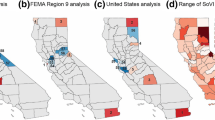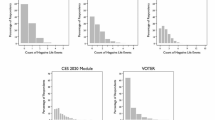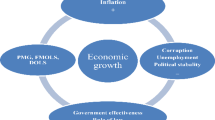Abstract
The relationship between political instability (PI) and economic development has been extensively debated in the social sciences, yielding contrasting empirical results. In this article, we synergise two novel techniques—synthetic control (SC) and matrix completion (MC)—to study the economic effects of PI events on the sub-Saharan African scene. Our identification strategies capture potential spatial and temporal heterogeneities of treatment effects. We show that PI inflicts statistically and economically significant collateral damage, albeit heterogeneous across economies and over time. Notably, the group average treatment effect on the treated (ATT) reveals output shrinkage of approximately 17–20 percentage points. Exploiting the temporal dimension of the two techniques, we find that although output loss persists into the long run, the bulk of the damage is wrecked in the short run. This finding particularly casts doubt on the full economic recovery hypothesis in the near aftermath of a PI episode. Furthermore, we unearth spatial heterogeneities of the effects where we show that the negative effects are disproportionately more pronounced for economies which experience protracted PI episodes. Lastly, our paper demonstrates that while both methods provide reliable counterfactuals, the MC estimator yields significantly better pre-treatment fit in our data than the SC framework.














Similar content being viewed by others
Availability of data and material
All data and materials leveraged in the analysis are publicly available, and all the sources to draw the data are disclosed in the manuscript.
Notes
We use the term SSA region broadly to encompass all economies wholly or partially located to the south of the Sahara desert–including Djibouti and Somalia, whose categorisation varies across different sources.
We relax this assumption in our empirical application.
In our analysis, as we document below, \(j = 1\) could be any of the nineteen SSA countries which experienced PI episodes during the 1980–2013 window, while the donor pool comprises of all other African countries that did not experience any PI episode during the entire study period (1965–2013).
Please see Liu et al. (2022) for a detailed formal discussion of the model specifications.
Our choice of a decade-long post-treatment window is also inspired by Abadie et al. (2015).
Similar inclusion criteria were used by Adhikari et al. (2018) in their study of reform waves using the SC framework.
Although Eritrea also meet our case selection criteria, the country is dropped due to data paucity.
This precludes Angola, Benin, Chad, Mauritius, Morocco, Mozambique, Nigeria, Uganda and Zimbabwe.
Alternatively, one is suggested to employ the Demeaned synthetic control (due to Ferman and Pinto 2021) in order to circumvent this challenge. Note that this paper does not pursue this route since our goal is to compare the prototype SC against its prototype MC counterpart.
See Abadie (2021) for a related discussion on data requirements in the practical application of SC frameworks.
Note that our results remain robust to the exclusion of exogenous matching covariates (see Sect. 5.2.3).
Please refer to Ben-Michael et al. (2022) for a formal contextual discussion of the SSC variant.
We also attempted this exercise using the interactive fixed effects counterfactual (IFEct) approach, whose results remain robust to those of the MC estimator. Nevertheless, the IFEct estimator is outperformed by the latter. Results for the IFEct estimations may be obtained from the authors upon a written request.
All MC estimates are based on unit-level bootstraps with 200 replications.
In fact, Hodler (2019) provides evidence of full economic recovery 17 years following the 1994 Rwandan genocide.
A subset of treated countries that share physical borders with members of the donor pool includes: Burundi, Burkina Faso, Central African Republic, Republic of Congo, Gambia, Mali and Rwanda.
We also report the results of this exercise for the SC framework in Fig. 16. Indeed, the SC results largely corroborate those obtained by the MC estimator.
These results can be accessed from the authors upon request.
We owe an anonymous referee for this observation.
References
Abadie A (2021) Using synthetic controls: feasibility, data requirements, and methodological aspects. J Econ Lit 59(2):391–425. https://doi.org/10.1257/jel.20191450
Abadie A, Gardeazabal J (2003) The economic costs of conflict: a case study of the Basque Country. Am Econ Rev 93(1):113–132. https://doi.org/10.1257/000282803321455188
Abadie A, Diamond A, Hainmueller J (2010) Synthetic control methods for comparative case studies: estimating the effect of California’s tobacco control program. J Am Stat Assoc 105(490):493–505. https://doi.org/10.1198/jasa.2009.ap08746
Abadie A, Diamond A, Hainmueller J (2015) Comparative politics and the synthetic control method. Am J Polit Sci 59(2):495–510. https://doi.org/10.1111/ajps.12116
Abadie A, L’hour J (2021) A penalized synthetic control estimator for disaggregated data. J Am Stat Assoc 116(536):1817–1834. https://doi.org/10.1080/01621459.2021.1971535
Abadie A, Vives-i-Bastida J (2023) Synthetic controls in action. Econom Soc Monogr (Forthcoming)
Adelman I, Morris C (1973) Economic growth and social equity in developing countries. Stanford University Press, Stanford
Adhikari B, Duval R, Hu B, Loungani P (2018) Can reform waves turn the tide? Some case studies using the synthetic control method. Open Econ Rev 29(4):879–910. https://doi.org/10.1007/s11079-018-9490-3
Aisen A, Veiga FJ (2013) How does political instability affect economic growth? Eur J Pol Econ 29:151–167. https://doi.org/10.1016/j.ejpoleco.2012.11.001
Alesina A, Özler S, Roubini N, Swagel P (1996) Political instability and economic growth. J Econ Growth 1(2):189–211. https://doi.org/10.1007/BF00138862
Athey S, Bayati M, Doudchenko N, Imbens G, Khosravi K (2021) Matrix completion methods for causal panel data models. J Am Stat Assoc 116(536):1716–1730. https://doi.org/10.1080/01621459.2021.1891924
Azariadis C, Drazen A (1990) Threshold externalities in economic development. Q J Econ 105(2):501–526. https://doi.org/10.2307/2937797
Bates RH, Epstein DL, Goldstone JA, Gurr TR, Harff B, Kahl CH, Knight K, Levy MA, Lustik M, Marshall MG et al (2003) Political instability task force report: Phase IV findings. Science Applications International Corporation, McLean
Benhabib J, Rustichini A (1996) Social conflict and growth. J Econ Growth 1(1):125–142. https://doi.org/10.1007/BF00163345
Ben-Michael E, Feller A, Rothstein J (2022) Synthetic controls with staggered adoption. J R Stat Soc Ser B Stat Methodol 84(2):351–381. https://doi.org/10.1111/rssb.12448
Bertin S, Ohana S, Strauss-Kahn V (2016) Revisiting the link between political and financial crises in Africa. J Afr Econ 25(3):323–366. https://doi.org/10.1093/jae/ejv025
Billmeier A, Nannicini T (2013) Assessing economic liberalization episodes: a synthetic control approach. Rev Econ and Stat 95(3):983–1001. https://doi.org/10.1162/REST_a_00324
Bircan Ç, Brück T, Vothknecht M (2017) Violent conflict and inequality. Oxf Dev Stud 45(2):125–144. https://doi.org/10.1080/13600818.2016.1213227
Blattman C, Miguel E (2010) Civil war. J Econ Lit 48(1):3–57. https://doi.org/10.1257/jel.48.1.3
Bluszcz J, Valente M (2022) The economic costs of hybrid wars: the case of Ukraine. Def Peace Econ 33(1):1–25. https://doi.org/10.1080/10242694.2020.1791616
Bove V, Elia L, Smith RP (2017) On the heterogeneous consequences of civil war. Oxf Econ Pap 69(3):550–568. https://doi.org/10.1093/oep/gpw050
Cattaneo MD, Feng Y, Titiunik R (2021) Prediction intervals for synthetic control methods. J Am Stat Assoc 116(536):1865–1880. https://doi.org/10.1080/01621459.2021.1979561
Cerra V, Saxena SC (2008) Growth dynamics: the myth of economic recovery. Am Econ Rev 98(1):439–57. https://doi.org/10.1257/aer.98.1.439
Clément MJA (2005) Postconflict economics in Sub-Saharan Africa, lessons from the Democratic Republic of the Congo. International Monetary Fund
Collier P (1999) On the economic consequences of civil war. Oxf Econ Pap 51(1):168–183. https://doi.org/10.1093/oep/51.1.168
Costalli S, Moretti L, Pischedda C (2017) The economic costs of civil war: synthetic counterfactual evidence and the effects of ethnic fractionalization. J Peace Res 54(1):80–98. https://doi.org/10.1177/0022343316675200
De Groot OJ, Bozzoli C, Alamir A, Brück T (2022) The global economic burden of violent conflict. J Peace Res 59(2):259–276. https://doi.org/10.1177/00223433211046823
De Haan J, Siermann CL (1996) Political instability, freedom, and economic growth: some further evidence. Econ Dev Cult Chang 44(2):339–350. https://doi.org/10.1086/452217
Devereux MB, Wen J-F (1998) Political instability, capital taxation, and growth. Eur Econ Rev 42(9):1635–1651. https://doi.org/10.1016/S0014-2921(97)00100-1
Farzanegan MR (2020) The economic cost of the Islamic revolution and war for Iran: synthetic counterfactual evidence. Def Peace Econ 33(2):1–21. https://doi.org/10.1080/10242694.2020.1825314
Ferman B, Pinto C (2021) Synthetic controls with imperfect pretreatment fit. Quant Econ 12(4):1197–1221. https://doi.org/10.3982/QE1596
Fosu AK (1992) Political instability and economic growth: evidence from Sub-Saharan Africa. Econ Dev Cult Chang 40(4):829–841. https://doi.org/10.1086/451979
Galiani S, Quistorff B (2017) The synth_runner package: utilities to automate synthetic control estimation using synth. Stand Genomic Sci 17(4):834–849
Gleditsch NP, Wallensteen P, Eriksson M, Sollenberg M, Strand H (2002) Armed conflict 1946–2001: a new dataset. J Peace Res 39(5):615–637. https://www.jstor.org/stable/1555346
Gobillon L, Magnac T (2016) Regional policy evaluation: interactive fixed effects and synthetic controls. Rev Econ Stat 98(3):535–551. https://doi.org/10.1162/REST_a_00537
Hodler R (2019) The economic effects of genocide: evidence from Rwanda. J Afr Econ 28(1):1–17. https://doi.org/10.1093/jae/ejy008
Jánossy F (1971) The end of the economic miracle: appearance and reality in economic development. Routledge
Jong-A-Pin R (2009) On the measurement of political instability and its impact on economic growth. Eur J Pol Econ 25(1):15–29. https://doi.org/10.1016/j.ejpoleco.2008.09.010
Kang S, Meernik J (2005) Civil war destruction and the prospects for economic growth. J Politics 67(1):88–109. https://doi.org/10.1111/j.1468-2508.2005.00309.x
Koubi V (2005) War and economic performance. J Peace Res 42(1):67–82. https://doi.org/10.1177/0022343305049667
Kugler J, Arbetman M (1989) Exploring the “phoenix factor’’ with the collective goods perspective. J Confl Resolut 33(1):84–112. https://doi.org/10.1177/0022002789033001004
Liu L, Wang Y, Xu Y (2022) A practical guide to counterfactual estimators for causal inference with time-series cross-sectional data. Am J Political Sci. https://doi.org/10.1111/ajps.12723
Marshall MG, Cole BR (2009) Global report 2009: conflict, governance, and state fragility. Center for Systemic Peace
Matta S, Bleaney M, Appleton S (2022) The economic impact of political instability and mass civil protest. Econ Pol 34(1):253–270. https://doi.org/10.1111/ecpo.12197
Mueller H (2013) The economic cost of conflict. Work. Pap., Int. Growth Cent., London
Murdoch JC, Sandler T (2002) Economic growth, civil wars, and spatial spillovers. J Confl Resolut 46(1):91–110. https://www.jstor.org/stable/3176241
Organski AF, Kugler J (1977) The costs of major wars: the phoenix factor. Am Pol Sci Rev 71(4):1347–1366. https://doi.org/10.2307/1961484
Pesaran MH, Smith RP (2016) Counterfactual analysis in macroeconometrics: an empirical investigation into the effects of quantitative easing. Res Econ 70(2):262–280. https://doi.org/10.1016/j.rie.2016.01.004
Polachek SW, Sevastianova D (2012) Does conflict disrupt growth? Evidence of the relationship between political instability and national economic performance. J Int Trade Econ Dev 21(3):361–388. https://doi.org/10.1080/09638191003749783
Rubin DB (1980) Randomization analysis of experimental data: the Fisher randomization test comment. J Am Stat Assoc 75(371):591–593. https://doi.org/10.2307/2287653
Solow RM (1956) A contribution to the theory of economic growth. Q J Econ 70(1):65–94. https://doi.org/10.2307/1884513
Svensson J (1998) Investment, property rights and political instability: theory and evidence. Eur Econ Rev 42(7):1317–1341. https://doi.org/10.1016/S0014-2921(97)00081-0
Themnér L, Wallensteen P (2012) UCDP/PRIO Armed Conflict Dataset, v. 4-2012, 1946–2011, Uppsala Conflict Data Program. Peace Research Institute Oslo
Vonyó T (2008) Post-war reconstruction and the golden age of economic growth. Eur Rev Econ His 12(2):221–241. https://doi.org/10.1017/S1361491608002244
Wan S-K, Xie Y, Hsiao C (2018) Panel data approach vs synthetic control method. Econ Lett 164:121–123
Winkelried D, Urquizo C (2021) The economic effects of international administrations: the cases of Kosovo and East Timor. Econ Dev Cult Chang 69(2):869–901. https://doi.org/10.1086/703102
Acknowledgements
The authors are grateful to the Editor and the two anonymous referees for the constructive comments that substantially improved the paper. The authors are also indebted to Hung-Ju Chen, Diana Carillo, Dinarti Tarigan, Shu-Shiuan Lu, Ziyi Liu and participants at the 2022 Taiwan Economics Association Conference for helpful suggestions and discussions. The usual disclaimer applies.
Author information
Authors and Affiliations
Corresponding author
Ethics declarations
Competing Interests
The authors declare that they have no conflict of interests.
Human and animal rights
This article does not contain any studies with human participants or animals performed by any of the authors.
Additional information
Publisher's Note
Springer Nature remains neutral with regard to jurisdictional claims in published maps and institutional affiliations.
Appendices
Appendix A: Donor pool weights for SC framework
This Appendix presents the weights of the control units used in the construction of the SC counterfactuals (Table 3).
Appendix B: Other robustness checks
Dynamic treatment effect of PI: full donor pool vs leave-neighbours-out. Notes: The horizontal axis illustrates the number of years relative to the onset of the PI episode. For the MC estimator, the grey-shaded area represents the 90% confidence intervals obtained from the baseline estimates with full donor pool
SC Framework: dynamic treatment effects of PI episodes on GDP growth rate. Notes: The dashed line plots the GDP growth rate computed by recalibrating the SC framework on the log difference of GDP. The solid (dark) line depicts GDP growth rate computed by taking the year-on-year change of the baseline treatment effect. For the latter scenario, in each country, the observations start nine years before the onset of the PI episode since the growth rate in this case is computed post-SC estimation which was originally confined to 10 years pre-PI episode
Rights and permissions
Springer Nature or its licensor (e.g. a society or other partner) holds exclusive rights to this article under a publishing agreement with the author(s) or other rightsholder(s); author self-archiving of the accepted manuscript version of this article is solely governed by the terms of such publishing agreement and applicable law.
About this article
Cite this article
Zonda, J.M., Lin, CC. & Chang, MJ. On the economic costs of political instabilities: a tale of sub-Saharan Africa. Empir Econ 66, 137–173 (2024). https://doi.org/10.1007/s00181-023-02452-4
Received:
Accepted:
Published:
Issue Date:
DOI: https://doi.org/10.1007/s00181-023-02452-4
Keywords
- Political instability
- Economic recovery
- Economic growth
- Sub-Saharan Africa
- Matrix completion
- Synthetic control








